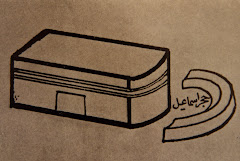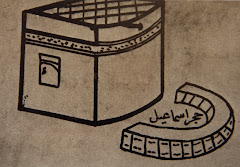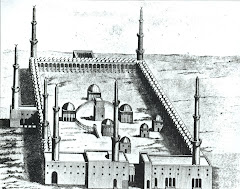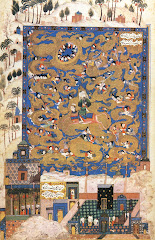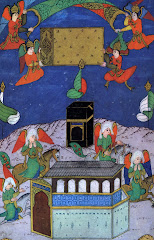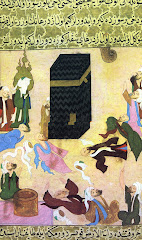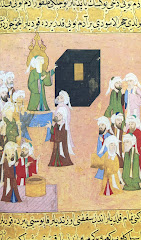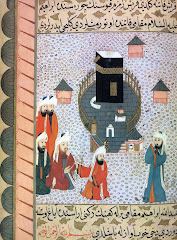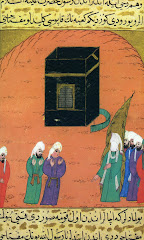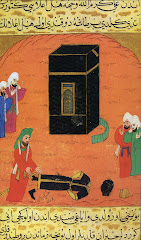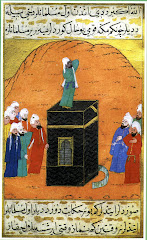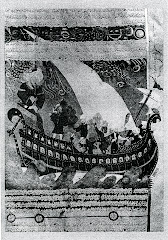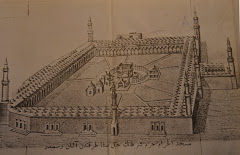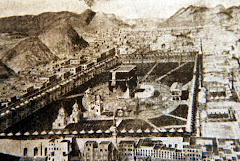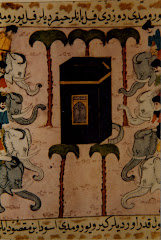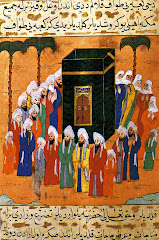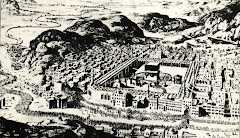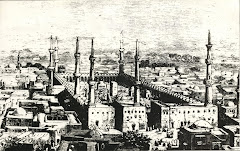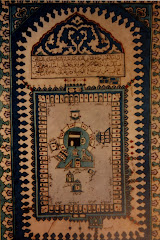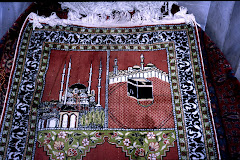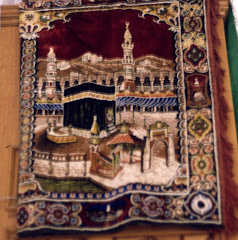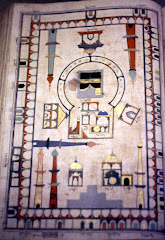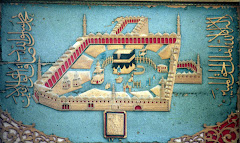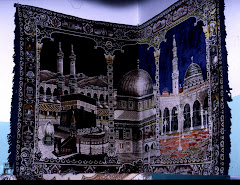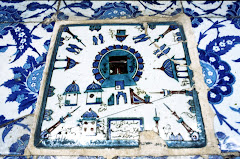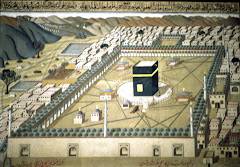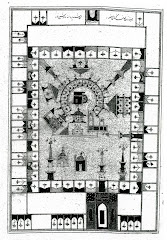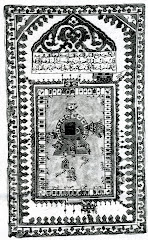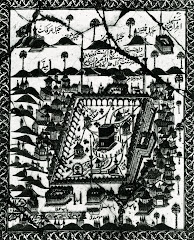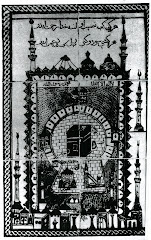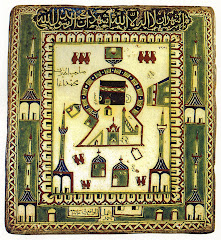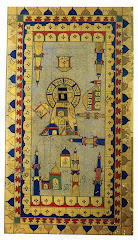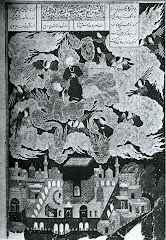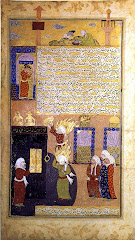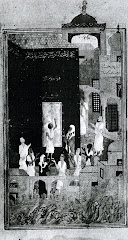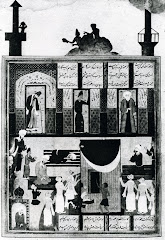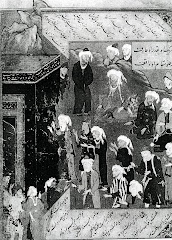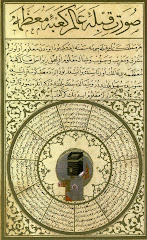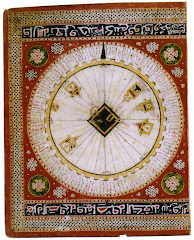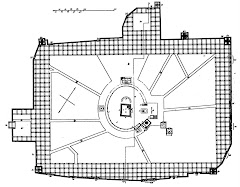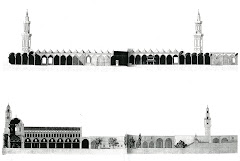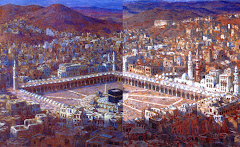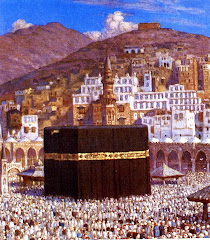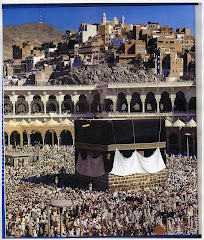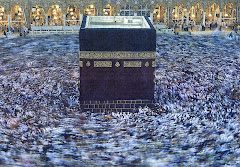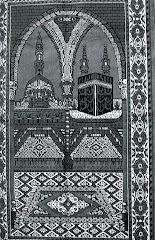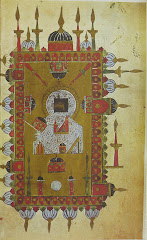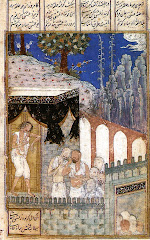(1) A. Di Vita (coord.), Alessandro Magno. Storia e mito, Martellago, 1995, pg. 338. The same subject, Alexander the Greats visit to the Ka’aba, is represented in The Shahnama by As Firdausi. The Ka’aba is located in the field. The black cloth covers the upper third part of the cube. Alexander is surrounded by men forming a circle who are welcoming him. (B.W. Robinson, The Persian Book of Kings. An Epitome of the Shahnama of Firdausi. London, 2002, pg. 81-83; A Descriptive Catalogue of the Persian Paintings in the Bodleian Library, Oxford, 1988, pg. 83, n. 593).
I would like to thank Dr. Bunes of CSIC and Dr. J. Carrero of the UNED for their collaboration. The photographs have been taken in Turkey by Dr. J. Storch of the UCM if not listed in the bibliography. Those of Iran are from the National Library in Teheran.
I would like to thank Dr. Bunes of CSIC and Dr. J. Carrero of the UNED for their collaboration. The photographs have been taken in Turkey by Dr. J. Storch of the UCM if not listed in the bibliography. Those of Iran are from the National Library in Teheran.
(2) Zeran Tanindi, Séller-i-Nebi. An Illustrated Cycle of the Life of Muhammed and its Place in Islamic Art, Eylül 1984, Min. III-IV.
(3) Zeren Tanindi, op. cit. P1.1.
(4) Zeren Tanindi, op. cit. P1.22.
(5) Zeren Tanindi, op. cit. P1.23.
(6)Zeren Tanindi, op. cit. P1.24.
(7) Zeren Tanindi, op. cit. P1.35.
(8) Zeren Tanindi, op. cit. P1.80.
(9) Zeren Tanindi, op. cit. P1.81.
(10) H. Stierlin, El Islam desde Bagdad hasta Córdoba, Cologne 2006, pg. 6.
(11) A. Bausani, L’Islam. Una religión, una etica, una prassi politica, Milan 1995, P1.8.
(12) Zeren Tanindi, op. cit. P1.75-76.
(13) M. Jenkins, Islamic Art in the Kuwait National Museum, Totwa 1983, pg. 122. J.M. Rogers, R.M. Ward, Süleyman the Magnificent, London 1998, pp. 100-101.
(14) A. Papadopoulos, El Islam y el arte musulmán, Barcelona 1997, fig. 450.
(15) M. Hattstein, P. Delius, Islam. Arte y Arquitectura, Barcelona 2004, pg. 12.
(16) M. Hattstein, P. Delius, op. cit. Pg. 41
(17) A. Papadopoulos, op. cit. Fig. 531.
(18) M. Hattstein, P. Delius, op. cit. Pg. 29.
(19) A. Papadopoulos, op. cit. Fig. 533. The same composition (fig. 47) repeats itself with significant variations in a Persian painting from Shiraz in the John Rylands Library, painted around 1575 (B. W. Robinson, Persian Paintings in the John Rylands Library. A Descriptive Catalogue, London, 1980, pg. 209, fig. 641). The Ka’aba was depicted very often in Persian paintings. It should suffice to remember the art pieces in the Bodleain Library. (B.W. Robinson, A Descriptive Catalogue of the Persian Paintings in the Bodleain Library, pg. 53, no. 543; pg. 56, no. 577; pg. 108, no. 873; pg. 109, no. 879, 880, 884; pg. 133, no. 1010; pg. 189, no. 1285).
(20) J. Renaia, Seven doors to Islam. Spirituality, the religious Life of Muslims, California 1996, pg. 53.
(21) Libro de la felicidad. Magali ‘al-Sa’det, Barcelona, pg. 10.
(22) M.-G. Guesdon, A. Vernay, L’Art du livre arabe. Du manuscrit au livre d’artiste, pg. 127.
(23) Viajes de Ali Bey, Barcelona 2001, pp. 315-331.
(24) D. Brahimi, K. Benchikou, La vie et le oeuvre de Etienne Donet, Tours 1991, pp. 127, 154-155, 258-259.
(25) I. Hervás, “Hacia el Imperio. De la consolidación a las más primeras divisiones”, Historia y Vida, 456, 2006, pg. 47.
(26) M. Hattstein, P. Delius, op. cit. Pg. 8. El País, January, 3, 2007, pg. 4.
(27) B. W. Robinson, Persian Painting in the Collection of the Royal Arabic Society, Wiltshire, 1998, pg. 13, picture 12.
(3) Zeren Tanindi, op. cit. P1.1.
(4) Zeren Tanindi, op. cit. P1.22.
(5) Zeren Tanindi, op. cit. P1.23.
(6)Zeren Tanindi, op. cit. P1.24.
(7) Zeren Tanindi, op. cit. P1.35.
(8) Zeren Tanindi, op. cit. P1.80.
(9) Zeren Tanindi, op. cit. P1.81.
(10) H. Stierlin, El Islam desde Bagdad hasta Córdoba, Cologne 2006, pg. 6.
(11) A. Bausani, L’Islam. Una religión, una etica, una prassi politica, Milan 1995, P1.8.
(12) Zeren Tanindi, op. cit. P1.75-76.
(13) M. Jenkins, Islamic Art in the Kuwait National Museum, Totwa 1983, pg. 122. J.M. Rogers, R.M. Ward, Süleyman the Magnificent, London 1998, pp. 100-101.
(14) A. Papadopoulos, El Islam y el arte musulmán, Barcelona 1997, fig. 450.
(15) M. Hattstein, P. Delius, Islam. Arte y Arquitectura, Barcelona 2004, pg. 12.
(16) M. Hattstein, P. Delius, op. cit. Pg. 41
(17) A. Papadopoulos, op. cit. Fig. 531.
(18) M. Hattstein, P. Delius, op. cit. Pg. 29.
(19) A. Papadopoulos, op. cit. Fig. 533. The same composition (fig. 47) repeats itself with significant variations in a Persian painting from Shiraz in the John Rylands Library, painted around 1575 (B. W. Robinson, Persian Paintings in the John Rylands Library. A Descriptive Catalogue, London, 1980, pg. 209, fig. 641). The Ka’aba was depicted very often in Persian paintings. It should suffice to remember the art pieces in the Bodleain Library. (B.W. Robinson, A Descriptive Catalogue of the Persian Paintings in the Bodleain Library, pg. 53, no. 543; pg. 56, no. 577; pg. 108, no. 873; pg. 109, no. 879, 880, 884; pg. 133, no. 1010; pg. 189, no. 1285).
(20) J. Renaia, Seven doors to Islam. Spirituality, the religious Life of Muslims, California 1996, pg. 53.
(21) Libro de la felicidad. Magali ‘al-Sa’det, Barcelona, pg. 10.
(22) M.-G. Guesdon, A. Vernay, L’Art du livre arabe. Du manuscrit au livre d’artiste, pg. 127.
(23) Viajes de Ali Bey, Barcelona 2001, pp. 315-331.
(24) D. Brahimi, K. Benchikou, La vie et le oeuvre de Etienne Donet, Tours 1991, pp. 127, 154-155, 258-259.
(25) I. Hervás, “Hacia el Imperio. De la consolidación a las más primeras divisiones”, Historia y Vida, 456, 2006, pg. 47.
(26) M. Hattstein, P. Delius, op. cit. Pg. 8. El País, January, 3, 2007, pg. 4.
(27) B. W. Robinson, Persian Painting in the Collection of the Royal Arabic Society, Wiltshire, 1998, pg. 13, picture 12.
Notas en castellano
(1) A. Di Vita (coord.), Alessandro Magno. Storia e mito, Martellago, 1995, pg. 338. El mismo tema, Alejandro Magno visitando la Ka’aba, se representa en The Shahnama por As Firdausi. La Ka’aba está situada en el campo. La tela negra cubre un tercio superior del cubo. Alejandro está rodeado por hombres formando un círculo que le dan la bienvenida. (B.W. Robinson, The Persian Book of Kings. An Epitome of the Shahnama of Firdausi. London, 2002, pg. 81-83; A Descriptive Catalogue of the Persian Paintings in the Bodleian Library, Oxford, 1988, pg. 83, n. 593).
Quisiera agradecer al Dr. Bunes del CSIC y al Dr. J. Cabrero de la UNED su colaboración. Las fotografías, si no se hace referencia a su procedencia, han sido realizadas en Turquía por el Dr. J. Storch de la UCM. Las correspondientes a Urán proceden de la Biblioteca Nacional en Teherán.
(2) Zeran Tanindi, Séller-i-Nebi. An Illustrated Cycle of the Life of Muhammed and its Place in Islamic Art, Eylül 1984, Min. III-IV.
(3) Zeren Tanindi, op. cit. P1.1.
(4) Zeren Tanindi, op. cit. P1.22.
(5) Zeren Tanindi, op. cit. P1.23.
(6) Zeren Tanindi, op. cit. P1.24.
(7) Zeren Tanindi, op. cit. P1.35.
(8) Zeren Tanindi, op. cit. P1.80.
(9) Zeren Tanindi, op. cit. P1.81.
(10) H. Stierlin, El Islam desde Bagdad hasta Córdoba, Cologne 2006, pg. 6.
(11) A. Bausani, L’Islam. Una religión, una etica, una prassi politica, Milan 1995, P1.8.
(12) Zeren Tanindi, op. cit. P1.75-76.
(13) M. Jenkins, Islamic Art in the Kuwait National Museum, Totwa 1983, pg. 122. J.M. Rogers, R.M. Ward, Süleyman the Magnificent, London 1998, pp. 100-101.
(14) A. Papadopoulos, El Islam y el arte musulmán, Barcelona 1997, fig. 450.
(15) M. Hattstein, P. Delius, Islam. Arte y Arquitectura, Barcelona 2004, pg. 12.
(16) M. Hattstein, P. Delius, op. cit. pg. 41.
(17) A. Papadopoulos, op. cit. fig. 531.
(18) M. Hattstein, P. Delius, op. cit. pg. 29.
(19) A. Papadopoulos, op. cit. fig. 533. La misma composición (fig. 47) se repite con variaciones significativas en una pintura persa de Shiraz en la Biblioteca John Rylands, pintada alrededor de 1575 (B. W. Robinson, Persian Paintings in the John Rylands Library. A Descriptive Catalogue, London, 1980, pg. 209, fig. 641). La Ka’aba es representada a menudo en las pinturas persas. Bastaría recordar las obras artísticas de la Biblioteca Bodleain (B.W. Robinson, A Descriptive Catalogue of the Persian Paintings in the Bodleain Library, pg. 53, no. 543; pg. 56, no. 577; pg. 108, no. 873; pg. 109, no. 879, 880, 884; pg. 133, no. 1010; pg. 189, no. 1285).
(20) J. Renaia, Seven doors to Islam. Spirituality, the religious Life of Muslims, California 1996, pg. 53.
(21) Libro de la felicidad. Magali ‘al-Sa’det, Barcelona, pg. 10.
(22) M.-G. Guesdon, A. Vernay, L’Art du livre arabe. Du manuscrit au livre d’artiste, pg. 127.
(23) Viajes de Ali Bey, Barcelona 2001, pp. 315-331.
(24) D. Brahimi, K. Benchikou, La vie et le oeuvre de Etienne Donet, Tours 1991, pp. 127, 154-155, 258-259.
(25) I. Hervás, “Hacia el Imperio. De la consolidación a las más primeras divisiones”, Historia y Vida, 456, 2006, pg. 47.
(26) M. Hattstein, P. Delius, op. cit. Pg. 8. El País, January, 3, 2007, pg. 4.
Quisiera agradecer al Dr. Bunes del CSIC y al Dr. J. Cabrero de la UNED su colaboración. Las fotografías, si no se hace referencia a su procedencia, han sido realizadas en Turquía por el Dr. J. Storch de la UCM. Las correspondientes a Urán proceden de la Biblioteca Nacional en Teherán.
(2) Zeran Tanindi, Séller-i-Nebi. An Illustrated Cycle of the Life of Muhammed and its Place in Islamic Art, Eylül 1984, Min. III-IV.
(3) Zeren Tanindi, op. cit. P1.1.
(4) Zeren Tanindi, op. cit. P1.22.
(5) Zeren Tanindi, op. cit. P1.23.
(6) Zeren Tanindi, op. cit. P1.24.
(7) Zeren Tanindi, op. cit. P1.35.
(8) Zeren Tanindi, op. cit. P1.80.
(9) Zeren Tanindi, op. cit. P1.81.
(10) H. Stierlin, El Islam desde Bagdad hasta Córdoba, Cologne 2006, pg. 6.
(11) A. Bausani, L’Islam. Una religión, una etica, una prassi politica, Milan 1995, P1.8.
(12) Zeren Tanindi, op. cit. P1.75-76.
(13) M. Jenkins, Islamic Art in the Kuwait National Museum, Totwa 1983, pg. 122. J.M. Rogers, R.M. Ward, Süleyman the Magnificent, London 1998, pp. 100-101.
(14) A. Papadopoulos, El Islam y el arte musulmán, Barcelona 1997, fig. 450.
(15) M. Hattstein, P. Delius, Islam. Arte y Arquitectura, Barcelona 2004, pg. 12.
(16) M. Hattstein, P. Delius, op. cit. pg. 41.
(17) A. Papadopoulos, op. cit. fig. 531.
(18) M. Hattstein, P. Delius, op. cit. pg. 29.
(19) A. Papadopoulos, op. cit. fig. 533. La misma composición (fig. 47) se repite con variaciones significativas en una pintura persa de Shiraz en la Biblioteca John Rylands, pintada alrededor de 1575 (B. W. Robinson, Persian Paintings in the John Rylands Library. A Descriptive Catalogue, London, 1980, pg. 209, fig. 641). La Ka’aba es representada a menudo en las pinturas persas. Bastaría recordar las obras artísticas de la Biblioteca Bodleain (B.W. Robinson, A Descriptive Catalogue of the Persian Paintings in the Bodleain Library, pg. 53, no. 543; pg. 56, no. 577; pg. 108, no. 873; pg. 109, no. 879, 880, 884; pg. 133, no. 1010; pg. 189, no. 1285).
(20) J. Renaia, Seven doors to Islam. Spirituality, the religious Life of Muslims, California 1996, pg. 53.
(21) Libro de la felicidad. Magali ‘al-Sa’det, Barcelona, pg. 10.
(22) M.-G. Guesdon, A. Vernay, L’Art du livre arabe. Du manuscrit au livre d’artiste, pg. 127.
(23) Viajes de Ali Bey, Barcelona 2001, pp. 315-331.
(24) D. Brahimi, K. Benchikou, La vie et le oeuvre de Etienne Donet, Tours 1991, pp. 127, 154-155, 258-259.
(25) I. Hervás, “Hacia el Imperio. De la consolidación a las más primeras divisiones”, Historia y Vida, 456, 2006, pg. 47.
(26) M. Hattstein, P. Delius, op. cit. Pg. 8. El País, January, 3, 2007, pg. 4.
(27) B. W. Robinson, Persian Painting in the Collection of the Royal Arabic Society, Wiltshire, 1998, pg. 13, picture 12.

